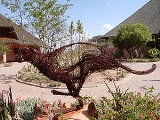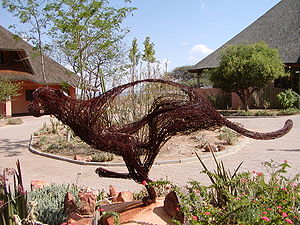
Cheetah Conservation Fund
Encyclopedia

The CCF is based in Namibia
Namibia
Namibia, officially the Republic of Namibia , is a country in southern Africa whose western border is the Atlantic Ocean. It shares land borders with Angola and Zambia to the north, Botswana to the east and South Africa to the south and east. It gained independence from South Africa on 21 March...
, the country with the largest and healthiest population of cheetahs left in the world. Its Research and Education Centre is located 44 km. east of Otjiwarongo
Otjiwarongo
Otjiwarongo is a city of 20,000 inhabitants in the Otjozondjupa Region of Namibia. It is the district capital of the Otjiwarongo electoral constituency and also the capital of Otjozondjupa....
.
The non-profit organization has developed a diverse range of programs to scientifically study cheetah physiology, its behavior, habitat, prey species and human and wildlife conflict issues. The results of these scientific studies are disseminated internationally via publications and presentations, and the ever-expanding scientific database is utilized to develop strategic education and conservation programs.
Both within Namibia and worldwide there is now far greater awareness of the value of the cheetah within the ecosystem, and its endangered status. Encouragingly, increasing numbers of Namibian farmers (on whose land the majority of wild cheetah live) are implementing predator-friendly livestock management techniques.
The work of the Cheetah Conservation Fund

Botswana
Botswana, officially the Republic of Botswana , is a landlocked country located in Southern Africa. The citizens are referred to as "Batswana" . Formerly the British protectorate of Bechuanaland, Botswana adopted its new name after becoming independent within the Commonwealth on 30 September 1966...
, Kenya
Kenya
Kenya , officially known as the Republic of Kenya, is a country in East Africa that lies on the equator, with the Indian Ocean to its south-east...
, South Africa
South Africa
The Republic of South Africa is a country in southern Africa. Located at the southern tip of Africa, it is divided into nine provinces, with of coastline on the Atlantic and Indian oceans...
, Algeria
Algeria
Algeria , officially the People's Democratic Republic of Algeria , also formally referred to as the Democratic and Popular Republic of Algeria, is a country in the Maghreb region of Northwest Africa with Algiers as its capital.In terms of land area, it is the largest country in Africa and the Arab...
and Iran
Iran
Iran , officially the Islamic Republic of Iran , is a country in Southern and Western Asia. The name "Iran" has been in use natively since the Sassanian era and came into use internationally in 1935, before which the country was known to the Western world as Persia...
.
Cheetah biology
CCF staff conducts field research to gather data on distribution, behaviour, biology, population demographics, livestock/cheetah interactions, and health of cheetahs.In order to influence national policy in favor of cheetah conservation, identify conservation priorities for cheetah, or assess the effectiveness of management action, CCF is currently developing indirect censusing techniques to provide consistent and reliable biological data. Building on long-term research on cheetah in Namibia, this project will field test and calibrate methods for cheetah censusing using camera-trap mark recapture and spoor (paw print) tracking. A cheetah genetics laboratory will provide support to the research and conservation endeavors necessary to save the cheetah, by using modern molecular techniques.
Cheetah ecology
The overall goal of the program is to enhance the long-term survival of the cheetah and other key indigenous wildlife species on Namibian farmlands by developing a habitat improvement program that is both ecologically sound and economically viable.CCF looks at cheetah and other predator population sizes, habitat, prey density and cheetah movements, and behavior in the Waterberg Conservancy (total 2,000 km²) and the Otjiwarongo
Otjiwarongo
Otjiwarongo is a city of 20,000 inhabitants in the Otjozondjupa Region of Namibia. It is the district capital of the Otjiwarongo electoral constituency and also the capital of Otjozondjupa....
farming area (15,000 km²). The CCF Research Center Farms (total 250 km²) are extensively studied, including habitat and prey species.

The program adds to and maintains an extensive physiological database and a Genome
Genome
In modern molecular biology and genetics, the genome is the entirety of an organism's hereditary information. It is encoded either in DNA or, for many types of virus, in RNA. The genome includes both the genes and the non-coding sequences of the DNA/RNA....
Resource Bank.
Human effects on the cheetah

- Research on the effective use of swing gates, the relocation of problem cheetahs, and the implementation of predator-friendly farming methods, such as the CCF's LivestockLivestockLivestock refers to one or more domesticated animals raised in an agricultural setting to produce commodities such as food, fiber and labor. The term "livestock" as used in this article does not include poultry or farmed fish; however the inclusion of these, especially poultry, within the meaning...
Guarding Dog Program, which has provided an efficient alternative method to reduce livestock losses to cheetahs and other predators. Greater awareness of the program has also led to an increase of requests by farmers who experience livestock predator problems to provide them dogs.
- The creation and management of long-term conservation strategies for the cheetah worldwide.

- CCF conducts integrated management courses to train and empower then on different aspects related to farming (i.e. sustainability) as well as on how to live with predators, particularly cheetahs. CCF also creates and disseminates education materials worldwide.
See also
- Asiatic CheetahAsiatic CheetahThe Asiatic Cheetah is now also known as the Iranian Cheetah, as the world's last few are known to survive mostly in Iran. Although recently presumed to be extinct in India, it is also known as the Indian Cheetah...
- Anatolian Shepherd DogAnatolian Shepherd DogThe Anatolian Shepherd Dog also known as Karabash is a breed of dog which originated in Anatolia and was further developed as a breed in America....
- Cheetah Conservation FoundationCheetah Conservation FoundationThe Cheetah Preservation Foundation is a conservation organization set up in South Africa in 1993 with special dedication to the protection of the endangered Cheetah. It is one of the largest wildlife organizations in Africa...

